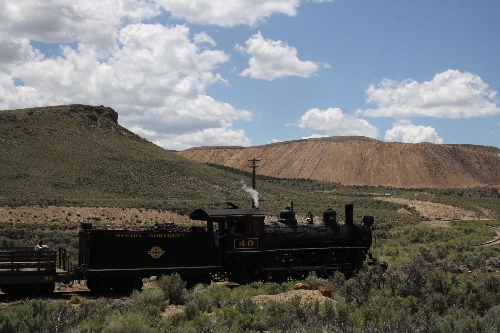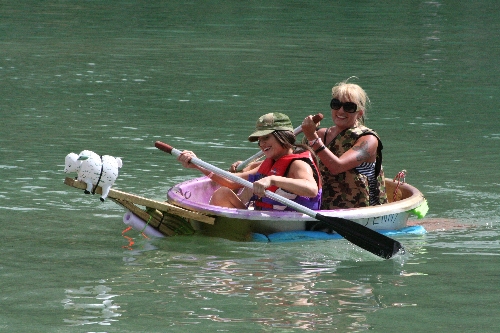A Little Relief
White Pine County, in eastern Nevada, has all the right ingredients for a cool rural escape from searing summers farther south. You won't find high-end hotels, spas or gourmet restaurants here, but there are nearly 9,000 square miles of hiking and biking trails, camping areas and fishing holes and plenty of opportunities to delve into the area's rich mining and railroad history. I try to get there at least once a season, and the last time was just a few weeks ago with my daughter, Charlotte, 13.
However you choose to spend most of your time there, devote at least some to the county seat, Ely. Although small -- home to only about 4,000 people -- the town is well equipped and well located as a rest-and-resupply center for the rural Nevada traveler. Visitors can find a clean room for the night, a square steak-and-apple pie meal in a restaurant or fast food. They can refill gasoline tanks, picnic hampers and ice chests, then head back into the agreeable summer countryside. It's an interesting place in its own right, and since it's more than 6,400 feet high, you won't have a heat stroke exploring it.
Ely got its start back in the 1860s when silver and gold were discovered, followed by rich copper finds in the early 1900s. Much of that past is preserved at the White Pine Public Museum, so we thought it appropriate to start our visit there. On the museum grounds we found a one-room log schoolhouse, originally built more than a century ago at Baker, near the Utah border. Here also was the charming 1906 train depot from Cherry Creek. And children love to step inside a cell from the old Ely City Jail.
Inside, we found a fine collection featuring dozens of antique dolls, some more than 100 years old. There also was a tribute to former first lady Pat Nixon, who was born in the area. A collection of Shoshone artifacts, including baskets, is on display.
Driving west a few miles on Highway 50, we turned off onto the gravel road that would take us to the 1,280-acre Garnet Hill Recreation Area, a part of the Egan Mountain Range designated by the Bureau of Land Management for enjoyment by rockhounds. This area is famous for its dark red garnets, which can be found in the volcanic rock. Generally, Charlotte and I don't have much interest in rock hounding, but finding blood-red semi-precious gems appealed even to us.
We hadn't thought to bring along hammers and chisels as more enterprising people do, but walked around turning over rocks to find the embedded jewels, visible because they're darker than the host rock. We also looked in small drainages for pieces that might have broken off and washed downhill. We ended up finding a dozen or so garnets, each about the size of a Grape-Nut.
Our next jaunt was south of town to the Ward Charcoal Ovens State Historic Park. It was just a mile or so north of the park that silver was discovered in 1872 and the Ward Mining District was born. During the district's short boom years, it is said, 1,500 people made their home here. But by 1879, low mining yields sent everyone off to more promising camps.
The park's six well-preserved ovens were built in the mid-1870s by Italian masons, who used locally quarried rock. Their shape suggests a fattened cone, or a big bullet pointed at the sky; each is about 30 feet tall and 27 feet in diameter. Each could hold about 35 cords of wood, which would end up as 1,750 bushels of charcoal, with a firing process often taking about 10 days. The charcoal was used to smelt ore from the nearby mines.
Our next stop was at Cave Lake State Park, in the Schell Creek Range about 15 miles southeast of Ely. We spent a couple of hours here watching one of the area's most popular and competitive annual events, the Cocktails and Cannons Bathtub Race.
Participants use a bathtub as the base of their craft, but from there they can fashion it as they please. There are motorized and nonmotorized divisions. It appeared that many of the crews hadn't tested their boats before the race. We watched as one small "boat" was boarded by two heavy and strong-looking voyagers, but even with all their muscle power the weight was too much to get any speed. Toward the end of one race, a vessel festooned with a dragon on its bow flipped completely over, dunking its three occupants into the drink. In another heat, the fastest boat didn't seem to know where to cross the finish line. The event's name is derived from the practice during the races of firing a replica artillery piece owned by the Ely Rotary Club, and the custom of consuming libations in the spirit of good fellowship.
While you will have to wait a year to see this race run again, Cave Lake is a great destination all summer. It's a 32-acre reservoir at an elevation of 7,300 feet, perfect for August camping. There are two campgrounds, a picnic area and a couple of hiking trails. The lake is famous for its naturally born brown trout and stocked rainbow trout. Some anglers fish through the ice in winter.
That evening, we headed into town seeking a hearty meal. We have found in the past that the two best choices for dinner are the Jailhouse Casino and the historic Hotel Nevada and Gambling Hall, located across the street from each other. We have stayed at the hotel several times and were never disappointed in the kind staff and good food.
The six-story hotel was built in 1929, and was the tallest building in Nevada at the time. It is said that although Prohibition was in effect when it opened, bootlegged liquor flowed freely, and plenty of gambling took place, even though that wasn't yet legal either. A couple of years later, when Congress repealed Prohibition and the Nevada Legislature legalized gambling, the Hotel Nevada already had a steady clientele for both activities and has retained it ever since. The lobby and casino area are filled with an eclectic mix of antiques, worth a quick look inside even if you're not staying or gambling there.
Ely sometimes calls itself "The City of Murals," and we took to the streets the next morning to see some along the town's Art Trail. The Ely Renaissance Society was responsible for getting this started, and we found it a great way to learn about White Pine County's rich history and the different ethnic groups that made homes here. A handy map and brochure guided us to about 20 murals and sculptures in the 11-block downtown area.
The Ely Renaissance Village is open on Saturdays and well worth visiting. Here, you will find restored houses from the early days of Ely. The houses are named for various ethnic groups that resided locally at one time or another, and the Greek House, Slavic House, Italian House and Asian House are decorated as their original residents actually did or might have at the time. The Asian House showcases Asian art, fans and parasols, while the English House has an elegant tea set, and the Italian House is decorated with lace.
We saved the most promising outing for our last day in Ely, when we headed over to ride the Nevada Northern Railroad. Many consider this railroad, established in 1906, one of the best preserved short lines in the West. We have taken the train a couple of times before, always heading east from the Ely depot, but this time we were on what's called the Keystone Route, which goes west past the main part of town. With perfect weather and cool temperatures, we chose to sit in the open-air car.
Most of our visits to White Pine County have included Great Basin National Park, but we didn't have time on this excursion. If you can make the time, I recommend it highly. It's only about 60 miles from Ely along Highway 50, often called "The Loneliest Road in America." Lonely's OK when you're on escape from the city. You won't see many people but will see rich ranch land dotted with cattle and view some impressive mountains.
Many come to the park to climb Wheeler Peak, at a lofty 13,063 feet, walk within the bristlecone pines or camp in some of the coolest temperatures in Nevada. But if I had just one day to spend there, I would devote much of it to a guided tour of Lehman Caves. These are limestone caverns hollowed from the mountains by running water, which also filled the caves with stalactites and stalagmites and the formations called "shields," the last almost unique to these caverns. Change in these formations is measured in fractions of inches per century, so what you see here is the same view a prehistoric visitor might have seen and the same your descendants may see 1,000 years hence. Here, in the middle of times changing too fast for comfort, you stop and behold the eternal.
Contact Deborah Wall at deborabus@aol.com.



















